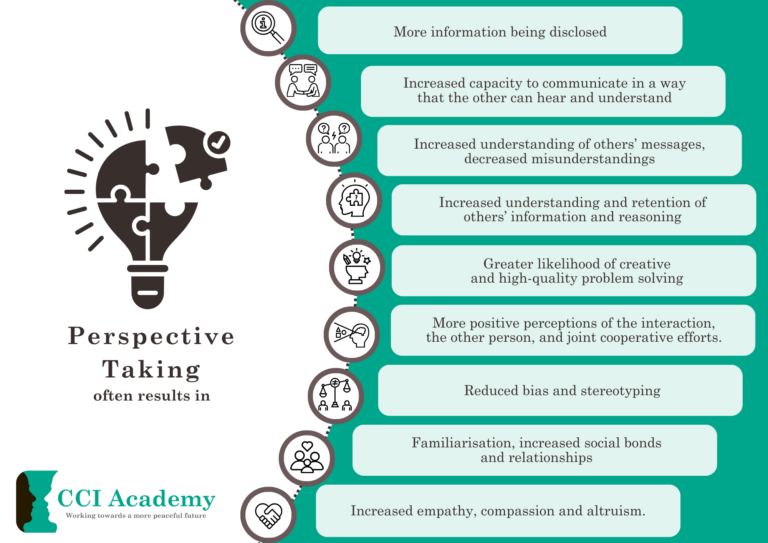Anyone who works with people in conflict understands the transformative power of perspective taking in resolving conflicts. In fact, a large part of the work of mediators and conflict management coaches involves supporting clients to see things from different perspectives.
Perspective taking often results in:
- More information being disclosed
- Increased capacity to communicate in a way that the other can hear and understand
- Increased understanding of others’ messages, decreased misunderstandings
- Increased understanding and retention of others’ information and reasoning
- Greater likelihood of creative and high-quality problem solving
- More positive perceptions of the interaction, the other person, and joint cooperative efforts.
- Reduced bias and stereotyping
- Familiarisation, increased social bonds and relationships
- Increased empathy, compassion and altruism.

While typically we think of the importance of a client understanding the perspective of the person with whom they are in conflict, this is not the only helpful perspective in transforming conflict. Other useful perspectives include those of:
- People who are impacted by the conflict (for example, children of parents in conflict)
- People who are observing the conflict (for example, colleagues in a workplace who are not directly involved in the conflict, but tend to be aware of it playing out)
- An independent perspective (whether that’s someone with expert knowledge or a layperson’s point of view).
It’s also useful to consider each of these different perspectives at varying points in time. For example, when I’m coaching, I often ask my clients to consider a “future you” perspective on whatever is on their mind. This can be surprisingly helpful to people who are stuck (in the present, or worse still, the past). You can also do the same with other people’s perspectives (for example, asking something like “when they are adults, how do you think your children might describe your behaviour during their childhood?”
Supporting someone to see things from different perspectives requires more than simply asking them to do so. To most effectively support a client to expand their perspective, a practitioner needs to understand the purpose or aim of the perspective taking attempt, what sources of information are being used and/or are available, and the kinds of interventions that support people to take new perspectives in a meaningful and sustainable way. There are particular ways of scaffolding a perspective-taking attempt to ensure that it is most likely to be productive, rather than simply asking “What do you think John is thinking right now?”
It’s also important to recognise that perspective taking does not necessarily help people understand what others truly think, feel or want. It may, however, help them to identify what they don’t know (and so motivate them to ask). Perspective taking, even when accurate, does not necessarily resolve the conflict – sometimes it can result in increased conflict and disagreement.

If you’d like to take a deeper dive into perspective taking, and how to support clients to engage in meaningful and sustainable efforts to understand their conflicts from a broad range of perspectives, register for our webinar on demand on this topic here: https://conflictmanagementacademy.com/webinar-on-demand-encouraging-perspective-taking-in-conflict/

